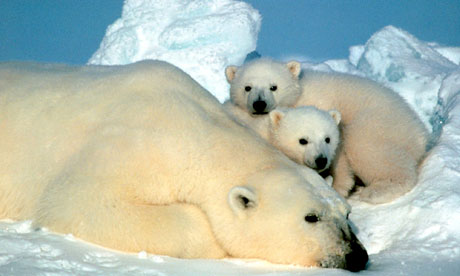Polar bear could be saved if emissions are cut, says new study
Ice caps not likely to face rapid, irreversible melting as previously thought, researcher claims – meaning polar bears could survive
- guardian.co.uk,
- Article history

The polar bear can be saved from extinction – but only if action is taken quickly to make deep cuts to greenhouse gas emissions, a new study shows.
The study, published today in journal Nature, conflicts with previous research, which suggested that Arctic temperatures are already on track to exceed the threshold required to trigger rapid, irreversible ice loss.
Researchers from Polar Bears International said sea ice in the Arctic, which polar bears use as a platform on which to hunt seals and breed, is unlikely to undergo a rapid and irreversible decline when temperatures rise beyond a certain threshold.
"It's widely believed that nothing can be done to save the polar bear," said author Steven Amstrup of Polar Bears International in Winnipeg, Canada. "But that's not true."
According to Andrew Derocher, a polar bear expert based at the University of Alberta in Edmonton, Canada who was not involved in the study, Amstrup's study is the first to assess whether a campaign to slash emissions will benefit polar bears. "Mitigation [of carbon emissions] was not considered by any of the analyses to date," he said.
Amstrup's team used global climate models and five scenarios of the level of greenhouse gas emissions to estimate sea ice loss in the Arctic over the next century. The paper suggests that there will be a linear relationship between temperature and sea ice: as temperatures rise, the amount of sea ice will decline smoothly.
If emissions continue to rise at today's rate, two-thirds of polar bears will disappear by 2050, the models suggest. Populations in Hudson Bay, Baffin Bay, the Southern Beaufort Sea and Barents Sea will be hit the hardest. In addition, the amount of optimal polar bear habitat in the Arctic will fall by 50%, according to Amstrup.
But stringent emissions cuts of 70% by 2100 would limit habitat loss to just 20% – saving the polar bear, says the study.
"Reduced emissions would yield greater abundance and wider distribution of polar bears than the 'business as usual' emission scenario," said Derocher of the paper.
Derocher is sceptical that policymakers will act to curb emissions in time. "There are few indications that such policies will be implemented in a timely manner. Globally, 25% of mammalian species are threatened with extinction and, in this context, the plight of polar bears is sadly typical," he said.
Loss of habitat isn't the only threat to Arctic species such as the polar bear, according to a separate paper published in Nature this week.
As sea ice melts, species that have been separated for thousands of years are expected to start to interbreed, generating novel hybrid species and driving existing rare species extinct.
"When human activities abruptly alter environments, it can increase the frequency of hybridisation, which can have negative effects, including pushing some species toward extinction," said lead author Brendan Kelly, who is based at the National Oceanic and Atmospheric Administration, Juneau, Alaska.
Kelly conducted a survey of published literature on hybridisation. He counted 34 hybridisation events between distinct populations, species and genera in marine mammals living in or near the Arctic.
The review was not focused on a specific period but is biased toward the most recent decades when research in the Arctic increased, and focused on the Arctic Ocean, where ice forms a diminishing barrier between marine mammals.
Of the 22 species that had hybridised, 14 were listed as endangered, threatened or of special concern in more than one country.
For example, a white bear with brown patches of fur was shot by Inuit hunters in 2006. DNA tests revealed that it was a half- polar bear, half-grizzly hybrid – also known as a "grolar" bear. In the late 1980s, a hybrid narwhal-beluga was seen off the west coast of Greenland, and last year, a hybrid bowhead-right whale was photographed in the Bering Sea

No comments:
Post a Comment